The Intel Skylake i7-6700K Overclocking Performance Mini-Test to 4.8 GHz
by Ian Cutress on August 28, 2015 2:30 PM ESTLinux Performance
C-Ray: link
C-Ray is a simple ray-tracing program that focuses almost exclusively on processor performance rather than DRAM access. The test in Linux-Bench renders a heavy complex scene offering a large scalable scenario.
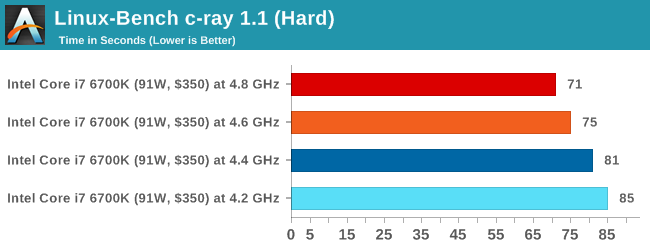
NAMD, Scalable Molecular Dynamics: link
Developed by the Theoretical and Computational Biophysics Group at the University of Illinois at Urbana-Champaign, NAMD is a set of parallel molecular dynamics codes for extreme parallelization up to and beyond 200,000 cores. The reference paper detailing NAMD has over 4000 citations, and our testing runs a small simulation where the calculation steps per unit time is the output vector.
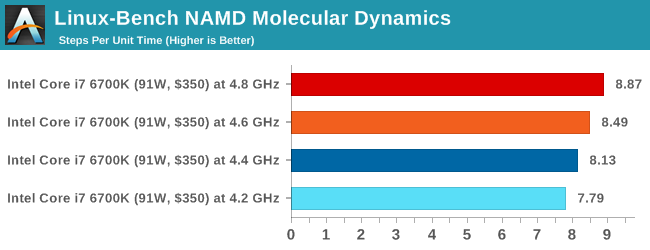
NPB, Fluid Dynamics: link
Aside from LINPACK, there are many other ways to benchmark supercomputers in terms of how effective they are for various types of mathematical processes. The NAS Parallel Benchmarks (NPB) are a set of small programs originally designed for NASA to test their supercomputers in terms of fluid dynamics simulations, useful for airflow reactions and design.
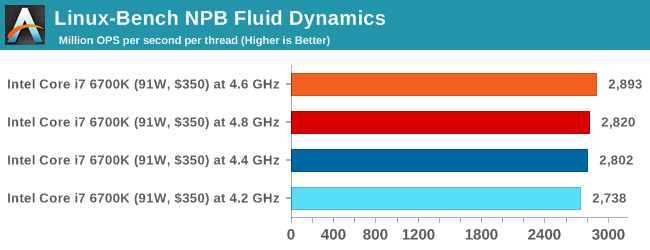
Redis: link
Many of the online applications rely on key-value caches and data structure servers to operate. Redis is an open-source, scalable web technology with a strong developer base, but also relies heavily on memory bandwidth as well as CPU performance.
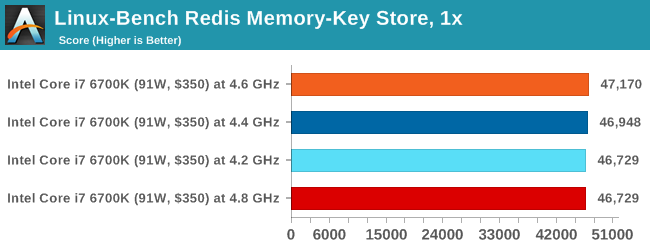
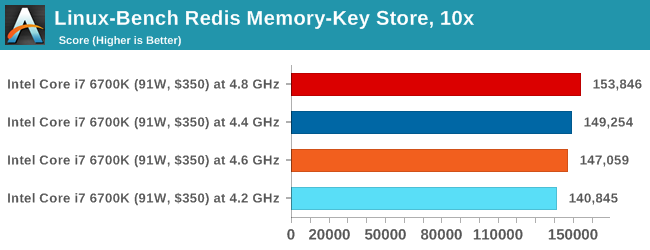
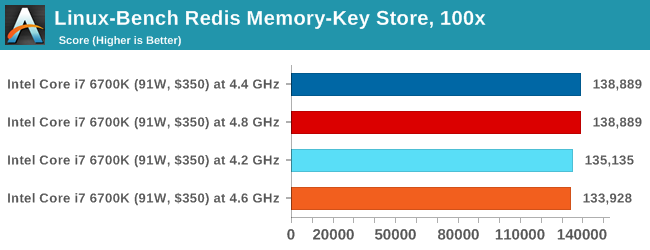
Conclusions on Linux-Bench
Our Linux testing actually affords ten tests, but we chose the most important to publish here (the other results can be found in Bench). But here we see some slight differences when it comes to overclocks - the NPB tests rely on multi-dimensional matrix solvers, which are often more cache/memory dependent and thus a higher frequency processor doesn't always help. With Redis, we are wholly cache/memory limited here. The other results are in-line with CPU performance deltas over the overclock range.










103 Comments
View All Comments
Oxford Guy - Saturday, August 29, 2015 - link
The problem is that overclocks should NEVER be called stable if they aren't.And, I don't like the way Anandtech pumps ridiculous amounts of voltage into chips (like they did with the 8320E).
Gigaplex - Sunday, September 27, 2015 - link
Production software in my books is any released software that completes a useful task, rather than just run synthetic tests.hyno111 - Saturday, August 29, 2015 - link
Is there a temperature chart for overclocking?sonny73n - Sunday, August 30, 2015 - link
Ian seems to miss the most important part in OCing.MrSpadge - Thursday, September 3, 2015 - link
The temperature depends strongly on your cooling, TIM application etc. If Ian included those numbers, people would be shouting "but I get different values with..."kneelbeforezod - Saturday, August 29, 2015 - link
12% better performance for a 32% power increase. uha.StrangerGuy - Saturday, August 29, 2015 - link
I OCed a cheapo AXP1700 by 25% on a budget nForce 2 board and stock cooling simply with FSB 266->333. I OCed my $183 E6300 that surpassed a $1000 X6800 in performance.Now, Intel and Asus et al thinks they are doing us a favor top-end mainstream CPUs that are barely overclockable on even on the most pricey of mobos, and hardly anyone calling out their bullshit, just because of unlocked multipiers? Gimme a break.
Am I the only sane guy here or what?
jihe - Monday, August 31, 2015 - link
That's why I'm still on nehalem, overclocking an x5650 is much more fun than this pay a premium to overclock crap that intel has been feeding us.SanX - Saturday, August 29, 2015 - link
Ian, add at least 4790k at 4.5-4.8GHz for us to see how bad new processors actually areV900 - Saturday, August 29, 2015 - link
Isn't this right about the usual time an AMD troll jumps in to tell us how you can overclock Kaveri to 5 Ghz, and you don't even need an aircooler or anything!